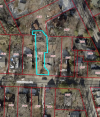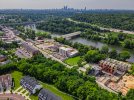Until my drone fell out of the sky for mysterious reasons, I would have agreed with you. But now that it has, well... I can't say that rare occurrences only happen to other people.I think DJI drones are extremely reliable. They very, very, rarely just fall out of the sky. Even the motors hardly ever fail in flight. If you are worried about the battery, you could tape it in so it can't fall out. I actually fly in urban areas 95% of the time.
You are using an out of date browser. It may not display this or other websites correctly.
You should upgrade or use an alternative browser.
You should upgrade or use an alternative browser.
Why did my Mavic Air 2 fall out of the sky after 1 minute of flight?
- Thread starter MNewman
- Start date
Absolutely NOT! I shoot rural, suburbs, and city listings daily. I'm just saying know your surroundings and try to fly in a manner so that "what if" does happen it does NOT happen on someone's head. Batteries fail, props break, Flight Controllers lose their minds all the time. Fly in a manner so that if something DOES fail the odds of it hitting someone etc is minimized to the best of your ability.So then in regards to real estate photography, would you suggest only shooting rural properties with expansive land and completely avoiding the suburbs and city?
I don't think I follow. Since there are clearly numerous reasons for why a drone can just fail and fall out of the sky that are not due to pilot error (i.e. parts just break/fail/disconnect on their own), that means the only way to prevent it from landing on someone's head is to not fly it where there are people. But a city is full of people. What manner of flying can prevent or even remotely limit the chance of a drone hitting somebody if it falls out of the sky in an urban area?Absolutely NOT! I shoot rural, suburbs, and city listings daily. I'm just saying know your surroundings and try to fly in a manner so that "what if" does happen it does NOT happen on someone's head. Batteries fail, props break, Flight Controllers lose their minds all the time. Fly in a manner so that if something DOES fail the odds of it hitting someone etc is minimized to the best of your ability.
What if the location I'm supposed to shoot for real estate is a skyscraper or a large 10+ story apartment building? Or even just a house in a neighborhood that's nothing but row homes?
Last edited:
Seems like this battery came off in flight, because of the poor design of early DJI drones where the battery was outside of the drone, and any swelling of the battery would make the mechanical connection between the drone and the battery even worse. I recommend you buy a DJI drone where the battery goes inside the drone, like the mavic 3, and fly it for a while in safe areas until you gain confidence the battery won't come out. I've had many 100's of flights with my mavic 3's, and never had a battery swell or come out in flight.I don't think I follow. Since there are clearly numerous reasons for why a drone can just fail and fall out of the sky that are not due to pilot error (i.e. parts just break/fail/disconnect on their own), that means the only way to prevent it from landing on someone's head is to not fly it where there are people. But a city is full of people. What manner of flying can prevent or even remotely limit the chance of a drone hitting somebody if it falls out of the sky in an urban area?
What if the location I'm supposed to shoot for real estate is a skyscraper or a large 10+ story apartment building? Or even just a house in a neighborhood that's nothing but row homes?
I don't think I follow. Since there are clearly numerous reasons for why a drone can just fail and fall out of the sky that are not due to pilot error (i.e. parts just break/fail/disconnect on their own), that means the only way to prevent it from landing on someone's head is to not fly it where there are people. But a city is full of people. What manner of flying can prevent or even remotely limit the chance of a drone hitting somebody if it falls out of the sky in an urban area?
What if the location I'm supposed to shoot for real estate is a skyscraper or a large 10+ story apartment building? Or even just a house in a neighborhood that's nothing but row homes?
I "do this" 5-7 days a week and I always fly in a way that MINIMIZES the risks to the best of my ability. I don't fly over people.... at all! Flying up over a Skyscraper or 10-story building doesn't sound at all safe.
I fly in neighborhoods daily but I'm aware of my surroundings and try to fly in a way that, IF somethings fails it hopefully does NOT intersect with a person.
Here's one of my shoots for Saturday morning:

Below are pictures of the kinds of places I often have to shoot aerial photos and videos of. This means shooting at 200-250 feet, 100-125 feet, and 40-70 feet. The video portion usually has a shot list that requires lateral moving arc shots around the property at each of those elevations, as well as shots descending to the properly while flying forward to introduce both the front and back of the building.I "do this" 5-7 days a week and I always fly in a way that MINIMIZES the risks to the best of my ability. I don't fly over people.... at all! Flying up over a Skyscraper or 10-story building doesn't sound at all safe.
I fly in neighborhoods daily but I'm aware of my surroundings and try to fly in a way that, IF somethings fails it hopefully does NOT intersect with a person.
Here's one of my shoots for Saturday morning:
View attachment 168481
But these are all in crowded locations -- i.e. the city. So for these examples, how do you propose I fly in a manner where I'm never flying over people for these shoots or in a way that I minimize the risk of anybody getting hurt should the drone suddenly fail and fall out of the sky, especially when the shoot has a shot list like the shots described above? Or would you suggest refusing to shoot in these locations outright?
Attachments
-
 DJI_0901_1.jpg4.2 MB · Views: 14
DJI_0901_1.jpg4.2 MB · Views: 14 -
 DJI_0884.jpg3.6 MB · Views: 14
DJI_0884.jpg3.6 MB · Views: 14 -
 DJI_0879.jpg4.1 MB · Views: 14
DJI_0879.jpg4.1 MB · Views: 14 -
 DJI_0823.jpg4.3 MB · Views: 12
DJI_0823.jpg4.3 MB · Views: 12 -
 DJI_0791.jpg3.6 MB · Views: 12
DJI_0791.jpg3.6 MB · Views: 12 -
 DJI_0568.jpg3.8 MB · Views: 12
DJI_0568.jpg3.8 MB · Views: 12 -
 DJI_0304.jpg3.7 MB · Views: 12
DJI_0304.jpg3.7 MB · Views: 12 -
 DJI_0302.jpg3.9 MB · Views: 10
DJI_0302.jpg3.9 MB · Views: 10 -
 DJI_0051.jpg4.2 MB · Views: 10
DJI_0051.jpg4.2 MB · Views: 10 -
 DJI_0949.jpg3.7 MB · Views: 14
DJI_0949.jpg3.7 MB · Views: 14
What city is that?Below are pictures of the kinds of places I often have to shoot aerial photos and videos of. This means shooting at 200-250 feet, 100-125 feet, and 40-70 feet. The video portion usually has a shot list that requires lateral moving arc shots around the property at each of those elevations, as well as shots descending to the properly while flying forward to introduce both the front and back of the building.
But these are all in crowded locations -- i.e. the city. So for these examples, how do you propose I fly in a manner where I'm never flying over people for these shoots or in a way that I minimize the risk of anybody getting hurt should the drone suddenly fail and fall out of the sky, especially when the shoot has a shot list like the shots described above? Or would you suggest refusing to shoot in these locations outright?
Dumeinao
Well-Known Member
Yeah AirData is amazingThe easy way is Airdata. It shows the battery S/N.
Is it at all possible that a flock of birds may have knocked the battery out? I do recall seeing a flock of birds in the sky near where I was shooting close to the time when I lost connectivity. Is this something that has been known to occur?
Bird strikes are in general extremely rare... & would then show sudden large attitude changes before the drone lose altitude & there perhaps goes out of LOS with a disconnection as a result which stops the log recording.Is it at all possible that a flock of birds may have knocked the battery out? I do recall seeing a flock of birds in the sky near where I was shooting close to the time when I lost connectivity. Is this something that has been known to occur?
Based on this, I think your suggestion about a bird strike that only, very rapidly, knocks out the battery without any recorded attitude changes... is highly unlikely.
So given the battery for my drone clearly lost connectivity for unknown reasons and then fell from the sky, would using gaffer's tape to tape the battery into the drone potentially prevent this from happening? Or is there some reason why this is a bad idea to do?
AMann
Well-Known Member
I
Good suggestion! I also push the battery down to see if it clicks in and pull also, but pushing it after that is the last movement for mine. Then I put a battery strap on it so it can’t pop out at all. The strap has Velcro on the outside also so I can attach a strobe and now my RID module to it.Someone doesn't know what they are talking about.
If the signal is lost/jammed the drone then initiates the Lost Signal action that has been established in the App. Default is usually Return To Home but it could be "Hover In Place". Neither of those are "cut power and fall to the ground".
A LiPo doesn't swell (aka PUFF) quickly unless there is some type of catastrophic discharge event (short in the cells, short in the aircraft wiring, short in the charge) and it puffs quickly with a high probability of catching fire if conditions are just right.
Here are my uneducated but experienced thoughts:
I have had my M2P battery "pop out" post flight. I got lucky that it didn't happen in flight. I was walking back to the car carrying the M2P by one of it's legs and the battery just popped right out completely. Best I can tell is that I had 1 of the 2 latches secure but that one eventually released but nothing was damaged. Now when I go to turn ON the aircraft I literally give the battery a good "pull" to make sure it's completely seated and a couple of times it was NOT.
- 1) Battery was not fully seated and battery disconnect occurred during flight.
- 2) Upon impact (either in the aircraft or apart from the aircraft) the battery suffered enough internal damage that it shorted out "internally" and caused the PUFF.
That's brilliant.I
Good suggestion! I also push the battery down to see if it clicks in and pull also, but pushing it after that is the last movement for mine. Then I put a battery strap on it so it can’t pop out at all. The strap has Velcro on the outside also so I can attach a strobe and now my RID module to it.
Do you have a link to that strap?
AMann
Well-Known Member
I’m surprised you guys don’t use them already, they’re super handy. Someone who used to be a member here first suggested them- here is the link:That's brilliant.
Do you have a link to that strap?
Apex RC Products 5 Pack 16mm x 300mm HD Rubberized Battery Straps Non-Slip 3021 Amazon.com
I put a 3M stick-on Velcro on the strap to attach my strobe on it- and now a second one for my Drone BS RID module also- place a piece of the fuzzy side around the strap like a ring so the two edges overlap for extra security. They are rubberized and don’t slip, plus the plastic ring on the end lets you cinch it down nice and tight.
Last edited:
Having a seat belt is always a good idea. But the real problem may be that the battery is swollen and the connection tabs aren't making a firm connection holding the battery in place. An accident waiting to happen.So given the battery for my drone clearly lost connectivity for unknown reasons and then fell from the sky, would using gaffer's tape to tape the battery into the drone potentially prevent this from happening? Or is there some reason why this is a bad idea to do?
Best you can do here is 1) stay over a house or building instead of people and 2) make sure your drone is in tip-top shape.What city is that?
- Joined
- Feb 8, 2018
- Messages
- 8,536
- Reactions
- 13,799
- Age
- 56
The straps , the velcro , even the Wet Suits work , but the problem is that we have seen the Battery just Crack open the bottom part of the drone and disconnect , its one of the most dangeous things that can happen as the drone is going to crash and catch fire or at min create a black smoke cloud for hours.
Understanding what causes the Batteries to Swell is even more important when it comes to the Mavic 2 such as water, moisture, or over charging caused my a comprimised power button on the battery. Were still flying the Mavic 2 and its orginal batteries as its been well protected.
Phantomrain.org
Gear to fly your Mavic 2 in the Rain. Land on the Water.
Understanding what causes the Batteries to Swell is even more important when it comes to the Mavic 2 such as water, moisture, or over charging caused my a comprimised power button on the battery. Were still flying the Mavic 2 and its orginal batteries as its been well protected.
Phantomrain.org
Gear to fly your Mavic 2 in the Rain. Land on the Water.
gadroneguy
Well-Known Member
I crashed my Air 2 for exactly the same reason - battery separation. Swollen batteries don't get good connections. The inherent design so that the batteries fall out when loose is a flaw. The Pro 3 has a better design.
Too bad. I did enjoy my Air 2, but do appreciate the better cameras from the newer drones.
I have come to realize that drones are not good long term investments.
Too bad. I did enjoy my Air 2, but do appreciate the better cameras from the newer drones.
I have come to realize that drones are not good long term investments.
Similar threads
- Replies
- 9
- Views
- 2K
- Replies
- 23
- Views
- 3K
- Replies
- 13
- Views
- 2K
- Replies
- 26
- Views
- 2K
- Replies
- 15
- Views
- 4K
DJI Drone Deals
New Threads
-
-
-
Air 3 Tales of the Riverbank - Henley on Thames - re visit
- Started by Pacefast
- Replies: 0
-
What triggers the requirement to use Python to calibrate gimbal mini 4K
- Started by DRONE HAPPY
- Replies: 1
-
3 firework show in Poland from Jan 1st 2026
- Started by marcinzmyslowski
- Replies: 0










